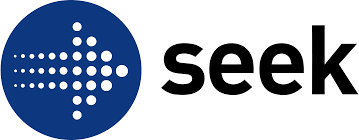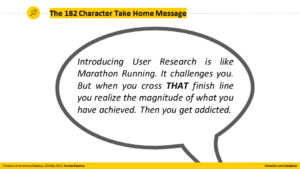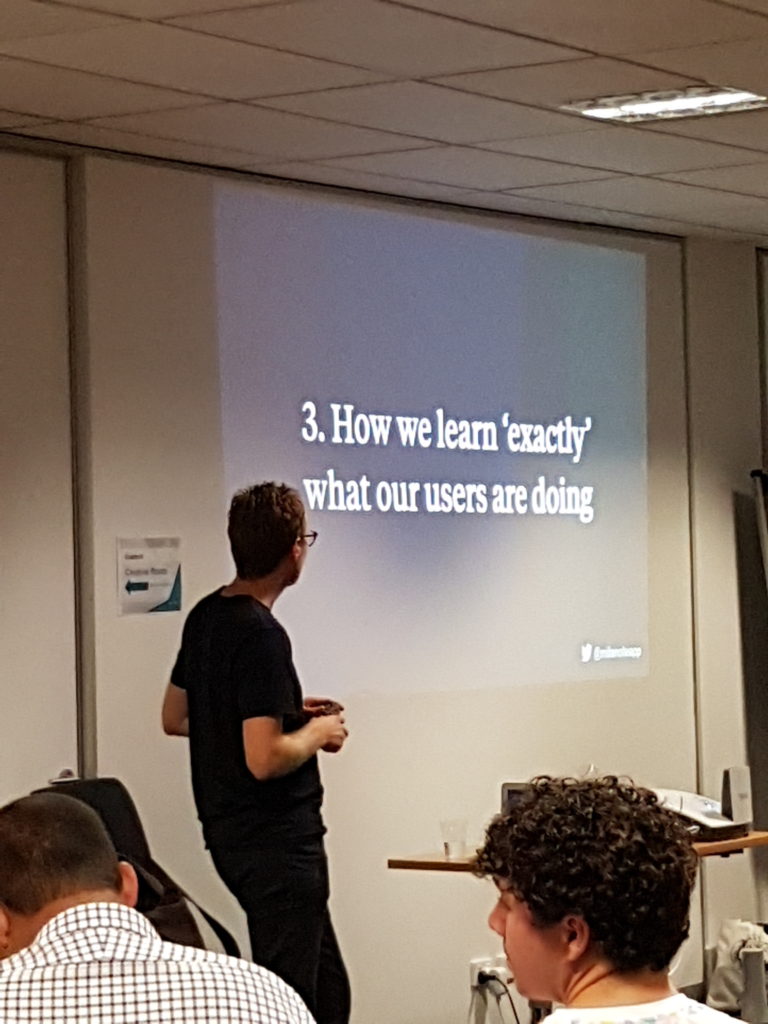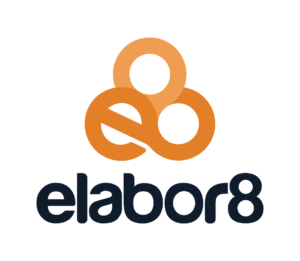WOW! What a fantastic evening! If you’re interested in user research, I hope you were there! Otherwise read on for the summary.
Big thanks to Fiona Knight, one of our volunteers, for taking great notes!
Awesome turnout for @product_anon “Working with User Research” #Meetup at @SEEK_Geek tonight. pic.twitter.com/DDmGVgNOgL
— Rob Scherer (@uxRob) May 25, 2017
Using Experience Sampling for Rapid Insights into User Needs
George Cockerill started the evening off with a discussion about how his team approached gathering user research in a project building a smart assistant for students at Deakin University.
The team decided to use the Experience Sampling method. Other methods like interviews & diary studies have participants recall their past whereas experience sampling gave them access to detailed immediate needs.
With experience sampling, you ask short, easy to answer questions throughout the day. For this project, the same two questions were sent to participants eight times a day over a week. Occasionally the team would add an optional question. Experience sampling allowed the team to get to very recent needs & the student’s behaviour.
Experience sampling gives accurate insights into recent needs and behaviour by asking the same Q 8 times a day. @GeorgeCockerill #prodanon pic.twitter.com/bjX7elUAue
— Rob Scherer (@uxRob) May 25, 2017
To collect the data, George used PACO, a free app that builds experiments quickly. It’s great for experience sampling and since it’s an app on participants’ phones they can take photos to include with their answers.
Tips for success
- Get maximum value for the method – be clear about the research goal
- Don’t rush, plan meticulously & plan to be flexible. Plan even when you need to go fast (it actually helps you move quickly!)
- It’s a complex set up – test it; test your questions and mechanics
- Get the most from people – recruit and onboard carefully. Establish how much data points you need to help determine how many participants you should have. When you screen them, ask questions along the lines of what you’ll be asking during the research. If they can’t answer in the screener, they probably won’t provide good data during the research. Your onboarding needs to have very clear instructions. George made a video to help explain the app and expectations of the participant (including what they needed to do /when they’d get paid).
- Monitor it! Experience sampling is not a ‘set it & forget it’ method. You can be encouraging to the participants or ask them to tell you more about a specific thing. It’s awesome if you can instill a shared purpose of what’s going to happen with the data they provide.
- Use the data to help refine the problem. Start finding themes, create categories, map answers to categories to find patterns, map data to graphs and examine categories to fine tune them. Look for trends. With participants using their phones, images will pick up detail the users might not think to say like how they solve their problems, their hacks, etc. You can combine the data with other research (both qual & quant). For this project, George combined experience sampling, resonance testing, journey maps from user interviews and ‘day in life’ models.
Onboarding your user as part of the experiment. Motivate & respect their time even with an incentive #prodanon
— Sarah Pan (@sarahpannz) May 25, 2017
Currently the student smart assistant is in a pilot with a set of students. We’re looking forward to hearing how it goes!
George recommended two excellent references that he found helpful in planning and running the research:
- Validating Product Ideas by Tomer Sharon
- Experience Sampling Method by Joel M Hektner and Mihaly Csikszentmihalyi
Why is marathon running important when introducing user research to an organisation?
Electronic Arts operates 8 research labs across 4 countries but it’s still early days for the games industry to embrace user research. In the APAC region, Kostas Kazakosis the 1st UX researcher at EA and thus needed to help communicate the value & importance of UX research.
Using ‘The Reflective Practioner‘ by Donald A Schon, Kostas reflected on his journey as a marathon runner and introducing UX research to a company – both ongoing!
Great session by Kostas Kazakos on introducing UX research at @EA_Australia #prodanon pic.twitter.com/PiGKoIyBnW
— Remya Ramesh (@rem_ram) May 25, 2017
Kostas finds there’s 8 stages to long distance running
- Excitement where anything is possible! The organisation has no prior exposure to formalised UX research.
- Denial when doubt starts to creep in. Here Kostas realised he didn’t know much about the FireMonkeys’ development process.
- Shock where everything seemed to be really difficult. Kostas had to show the value of UX research, create a research space and creating research protocols to suit the games industry. Kostas’s plan was relying on the importance of dialogue: talking to people, understand what they do, and showing UX research helps them. This is where empathy is important but how do you do this? You empathise with the data and people and match it to research question.
Talk to everyone. From the junior to GM. If you don’t understand the context you work in, how can you prove #ux value? #prodanon
— Sarah Pan (@sarahpannz) May 25, 2017
- Isolation or the fear you’re not going to make it. Having talked to as many people as possible, you need to accept the feedback and adjust your approach
- Despair usually happens about mile 19 in a marathon. When you start to question if you really can do this, if you’re ready to do this and will it be ok?
- The wall at mile 22 is when your brain doesn’t talk to your body anymore. You need to take one step at a time to keep going & identify mistakes and address them quickly. At EA, this meant all that earlier work to establish relationships with the team enabled collaboration. He had helped educate them & gave them ownership. The teams had begun the process of seeing the importance of data & value of user research.
- Affirmation at mile 23 is feeling like you have a break thru. This is the stage Kostas is currently at work. He’s seeing people want to get involved in the UX research and wants to be able to sustain that team participation.
- Elation at the finish line of mile 26 is when you’ve achieved the goal and need to shift your mindset towards the future. At work, this is what Kostas is working towards.
In summary, the DECEMA frame of reference that Kostas described – Dialogue, Empathy, Collaboration, Empowerment, Mutual respect and Advocacy – can take you a long way when introducing user research to your organization!
@product_anon @GeorgeCockerill Kostas Kazakos, Thank you! I got more professional development tonight, than from work in the past month.
— Sally Pryor (@Pryor365) May 25, 2017
Loved talking about Experience Sampling with ace Qs & conversations after. Thanks for having me @product_anon & brilliant hosts @SEEK_Geek https://t.co/PBlmb3gnOB
— George Cockerill (@GeorgeCockerill) May 27, 2017
Thanks to both George & Kostas for a great evening and to Seek for hosting us!!!




